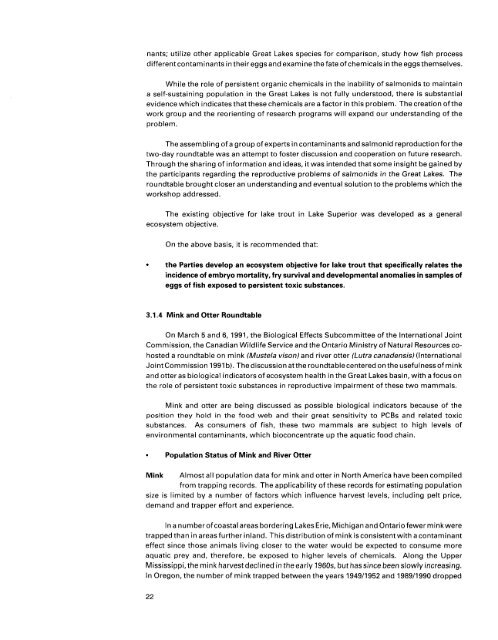International Joint Commission
International Joint Commission
International Joint Commission
You also want an ePaper? Increase the reach of your titles
YUMPU automatically turns print PDFs into web optimized ePapers that Google loves.
nants; utilize other applicable Great Lakes species for comparison, study how fish process<br />
different contaminants in their eggs and examine the fate of chemicals in the eggs themselves.<br />
While the role of persistent organic chemicals in the inability of salmonids to maintain<br />
a self-sustaining population in the Great Lakes is not fully understood, there is substantial<br />
evidence which indicates that these chemicals are a factor in this problem. The creation ofthe<br />
work group and the reorienting of research programs will expand our understanding of the<br />
problem.<br />
The assembling of a group of experts in contaminantsand salmonid reproduction forthe<br />
two-day roundtable was an attempt to foster discussion and cooperation on future research.<br />
Through the sharing of information and ideas, it was intended that some insight be gained by<br />
the participants regarding the reproductive problems of salmonids in the Great Lakes. The<br />
roundtable brought closer an understanding and eventual solution to the problems which the<br />
workshop addressed.<br />
The existing objective for lake trout in Lake Superior was developed as a general<br />
ecosystem objective.<br />
On the above basis, it is recommended that:<br />
the Parties develop an ecosystem objective for lake trout that specifically relates the<br />
incidence of embryo mortality, fry survival and developmental anomalies in samples of<br />
eggs of fish exposed to persistent toxic substances.<br />
3.1.4 Mink and Otter Roundtable<br />
On March 5 and 6, 1991, the Biological Effects Subcommittee of the <strong>International</strong> <strong>Joint</strong><br />
<strong>Commission</strong>, the Canadian Wildlife Service and the Ontario Ministry of Natural Resources cohosted<br />
a roundtable on mink (Mustela vison) and river otter (Lutra canadensis) (<strong>International</strong><br />
<strong>Joint</strong><strong>Commission</strong> 1991 b). Thediscussionatthe roundtablecenteredon the usefulnessof mink<br />
and otter as biological indicators of ecosystem health in the Great Lakes basin, with a focus on<br />
the role of persistent toxic substances in reproductive impairment of these two mammals.<br />
Mink and otter are being discussed as possible biological indicators because of the<br />
position they hold in the food web and their great sensitivity to PCBs and related toxic<br />
substances. As consumers of fish, these two mammals are subject to high levels of<br />
environmental contaminants, which bioconcentrate up the aquatic food chain.<br />
Population Status of Mink and River Otter<br />
Mink Almost all population data for mink and otter in North America have been compiled<br />
from trapping records. The applicability of these records for estimating population<br />
size is limited by a number of factors which influence harvest levels, including pelt price,<br />
demand and trapper effort and experience.<br />
In a number of coastal areas bordering Lakes Erie, Michigan and Ontariofewer minkwere<br />
trapped than in areas further inland. This distribution of mink is consistent with a contaminant<br />
effect since those animals living closer to the water would be expected to consume more<br />
aquatic prey and, therefore, be exposed to higher levels of chemicals. Along the Upper<br />
Mississippi, the mink harvest declined in the early 1960s, but has since been slowly increasing.<br />
In Oregon, the number of mink trapped between the years 1949/1952 and 1989/1990 dropped<br />
22

















